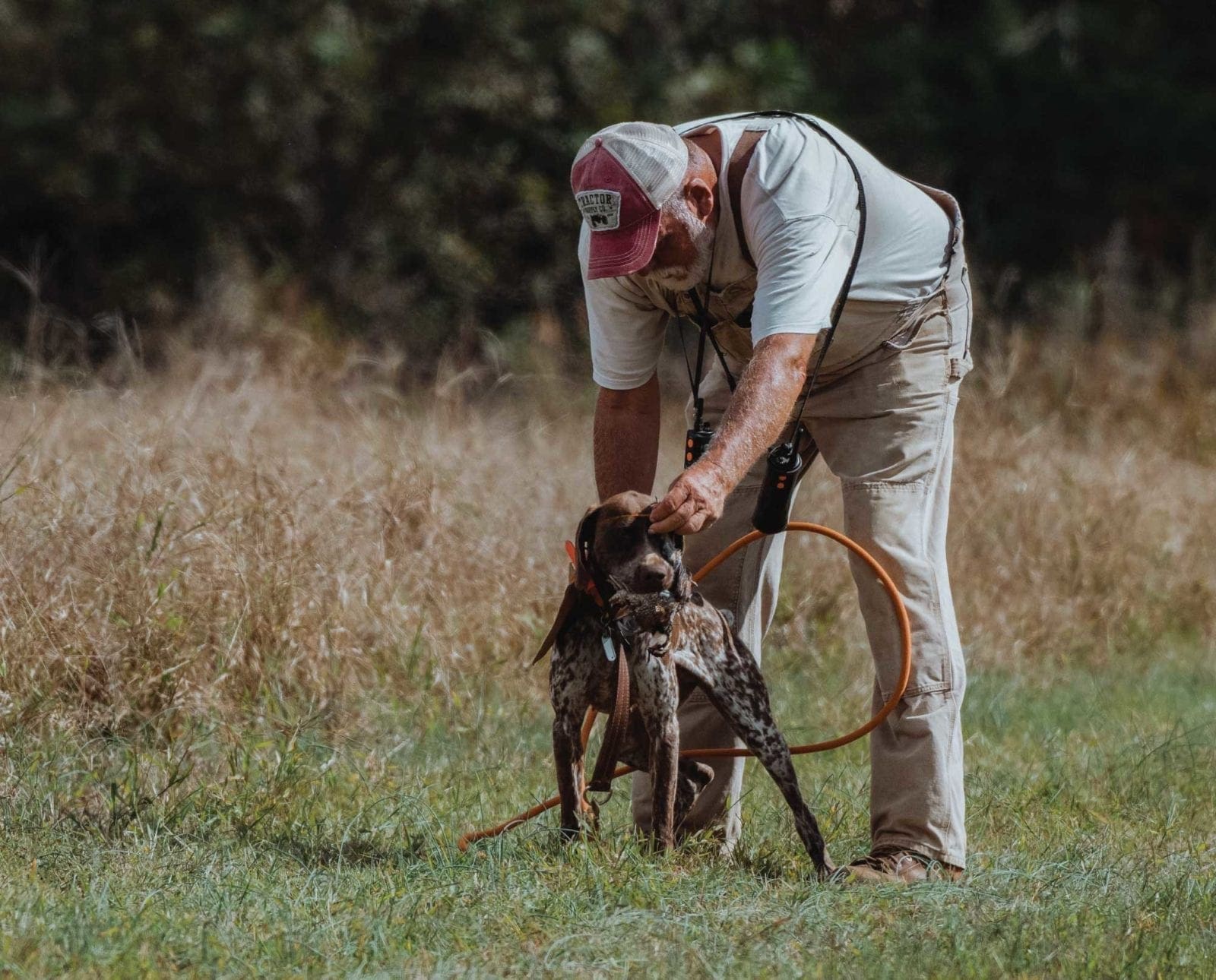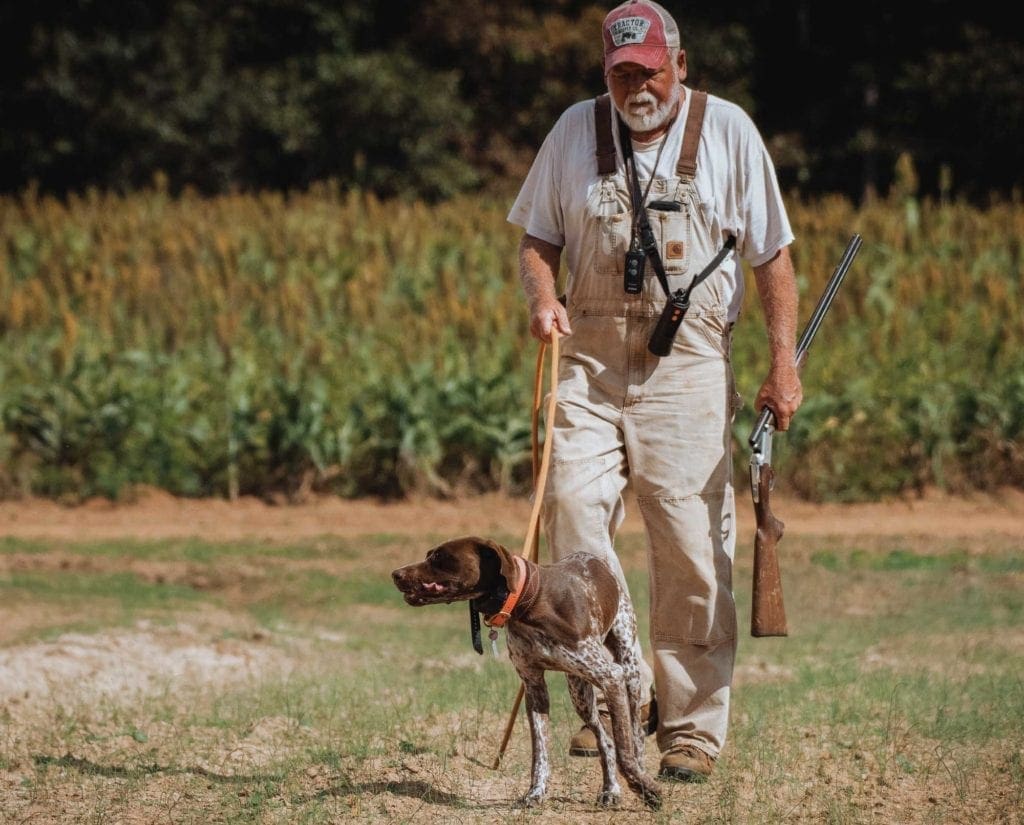Home » Hunting Dogs » The Gibbons-West Method of Pointing Dog Training with Mo Lindley
The Gibbons-West Method of Pointing Dog Training with Mo Lindley

Robb Moore has pursued the meaning of life from Tibetan…
Understanding the Gibbons-West method of training pointing dogs
As a first-time bird dog owner and handler, now four years into the project, and having lucked out with exposure to a few of the best mentors and trainers on the scene today, I feel like I’ve gotten another bachelor’s degree, this one in all things bird dog. At this stage of my life, if asked, I’d gladly trade any previous degree I have for that one. Throughout these past few years, I’ve reflected often on the training philosophies I’ve encountered, the most popular of which are capable of guiding any dedicated beginning trainer to success. While I’ve settled comfortably into a system that’s the best fit for my dog’s personality, disposition, talents, and weaknesses—as well as my own—I’m by nature and disposition a universalist and a comparativist.
Life for me is wondrous, rich, complex, and largely ineffable. Religions and dog training philosophies (the latter of which might as well be religions, too, for all the argument they can inspire) are no different. While systems—philosophical, practical, theological or otherwise—have internal interdependent logic elements that can’t be pulled apart and exchanged with those of other systems willy-nilly, they can sometimes find meaningful intersections with, overlap with, and/or complement other systems when done carefully and with humility.
There is admittedly some wisdom in counseling new handlers to do with training systems just what they should do with puppies in a litter with strong hunting lines: just reach in, pick any one, and stick with it. However, learning about and keeping in view other paths is not necessarily a bad thing, particularly for those whose learning style requires it. For example, I learn best in comparative study. So, my hope is that my own comparativist disposition might help others reviewing the do-it-yourself (or more accurately, do-it-with-a-lot-of-help) systems available to make sense of a dizzying array of options and find the proper fit for themselves, their dogs, and their individual situation.
Encountering the West/Gibbons dog training method with Mo Lindley
The first great system to which I was exposed as a newbie was the training style practiced and taught by Maurice (affectionately known as “Mo”) Lindley, a South Carolina kennel owner and dog trainer. Mo is one of the leading disciples/masters of what’s referred to as the West/Gibbons training methodology. As a result of Ménière’s disease, Mo has lost much of his hearing. Interestingly, though, his affliction seems only to have further developed his gift for understanding and communicating with dogs. Most good trainers will concede that verbal commands are the most difficult for a dog to understand and the West/Gibbons training style puts this fact to great use. It heavily privileges silent commands and relies on body language, action, and light e-collar stimulation that is not in any way meant to be punitive, but intended simply as a way to get a dog’s attention and/or serve as a way to communicate remotely with a dog in the field.
Mo regularly does exactly one, three-day, two-part (“foundation” and “advanced”) seminar a year. It’s hosted by Martha Greenlee, the author of the book that details Mo’s training methods, Training with Mo, at Martha’s kennel and farm, Piney Run. Martha’s farm is just outside of South Hill, Virginia, and—luckily for me—only about 90 minutes from my home. I’d read Martha’s book, The Brittany: Amateurs Training with Professionals, early in my Brittany training research before my wife and I got Lincoln. After I got over the happenstance of getting an unexpected chance to meet her while observing a fun trial in Southern Virginia, I immediately asked to put down a deposit for their April seminar. In doing so, I managed to secure reservations at one of the most sought-after annual training workshops in all of birddogdom.
Basic tenets of the West/Gibbons training approach
The Steady with Style website and its associated Facebook community are the best online homes for all things related to this training methodology, but the method is less a step-by-step, paint-by-numbers sort of system than it is about developing non-verbal and intuitive communication between a dog and its handler. Having said that, it does prescribe a plan of action from puppy introductory work through the process of finishing a dog. While there’s some recommended equipment, it’s easy to tell that there really isn’t a whole lot of interest in merchandizing it and selling it. After all, duct tape for the mouth of a chattering human handler is decidedly affordable.
Overall, compared to some of the other major systems I’ve considered—all of which seem to boast and achieve some regular success in getting the job done—it’s sort of the anti-system bird dog training system. It is probably the least formulaic of the training styles out there and is heavily based on gaining an intuitive read of a dog. This includes reading how he or she is reacting to training pressure and what the dog’s emotional energy and drive say about the best ways to employ training methods in any given situation or point of continuum of bird dog development. It certainly has some core philosophical tenets but, more than most training systems, emphasizes innovation, intuition, improvisation, and a general evolutionary trajectory from harsher “old-school” dog training methods to ones that involve fewer iron-fisted handlers and aversive techniques. It asks handlers and trainers to lean into the idea that the preferred techniques are generally the gentler ones and the ones that seem to make the most sense to the dogs themselves. This in turn means they are more likely to convince the dog that the human handler is appropriately in charge and worthy of the canine respect needed for the dog to willingly comply with training and commands.

Is the West/Gibbons training method good for beginners?
For a beginner, this is all both a blessing and a challenge. It’s a challenge because newbies like me are often desperate to find a neat step-by-step formula to learn the daunting and complicated challenges of getting our dogs to understand and obey us. It’s a blessing because the method moves us instead to first seek to understand our dogs and doesn’t let the beginner off the hook in realizing just how complicated the task of understanding our dogs is.
It also leads us to the revelation that it is daunting and complicated because an inter-species relationship and understanding and the development of one’s intuition about the alien geography of a dog’s mind are at the heart of the task. We’re not programming robots; we’re learning to bridge an inter-species communication gap. While that gap is smaller between co-evolved domesticated dogs and humans than between humans and any other non-primate species, a dog’s mind is still not easily intuited by a human, nor vice-versa. We therefore have to unlearn some of what serves us well and easily when communicating with other people, while keeping at least some of the same level of respect we afford our fellow human beings.
Mo readily recounts his own evolution from the old-school, harsh, handler-will-over-the-dog sort of methods, “which will get your dog to either run off or bite your ass when he’s got half a chance,” to ones that seek to develop a friendly and respectful partnership between handler and dog, based on the possibility of the development of a shared sense of trust and fairness. While it’s far from extreme (aversive techniques are not entirely eschewed), you do get the sense at least with Mo’s execution of the method that it’s still developing and still moving in a direction of gentleness and partnership and away from more forceful applications.
Even after three decades of expert work as a master of the art of bird dog training, with literally thousands of dogs, it is striking that Mo is still actively learning and seeking to try new applications of and derivations of the method himself as he continues to challenge his own understandings of the dog mind with each new dog he trains. I guess that’s what attracts me the most about this method: even the experts are humble and take seriously the challenge of bringing any given dog along in ways that respect the individuality of these wonderful creatures and do not reduce them to being mere tools in the service of bagging birds or winning at a sport. In fact, the method implies that focusing on working with the individual dog is considerably more likely to be successful, if we respect it as a conscious and willful individual being that can actively choose either to resist us or to partner with us.
As a guy who found a secondary love for upland bird hunting through the primary love of a specific dog, this general disposition in thought about training appeals very much to me and it’s easy to see and deeply admire the gentle, full-hearted spirit and love for dogs that its teachers and most enthusiastic adherents bring to the pursuit.
Takeaways from the Mo Lindley seminar
Despite my high expectations, the seminar somehow managed to exceed them. I just can’t say enough about the value of the immersive experience with Mo, Dave “Jonesy” Jones, and Martha and all the wonderful dogs and their owners in attendance. I’d read Martha’s book on Mo and had watched most of the recorded 2016 seminar before attending the 2018 seminar. Nevertheless, spending three days in back-and-forth dialogue with other handlers/owners/trainers and Mo, Jonesy, and Martha, and seeing them work with several different breeds of bird dogs in various stages of development was indispensable. Additionally, asking my own questions, experiencing them working with Lincoln, and having them coach me working with him in several exercises, brought me considerably further along in the method than I could have imagined.
Being in their presence and with fellow students so much further along than me, I walked away humbled by how little I currently knew. Paradoxically, I also left convinced that my love for Lincoln and my joy at seeing him develop would afford me some grace in whatever mistakes I might make in my own learning curve. I also walked away with a deeper appreciation that understanding and training dogs are—by their richness and rewards—worthy of a life-long journey. Surely, such a journey is one that demands to be consciously experienced in the precious short time we are privileged to love, be loved by, and joined by these amazing animals in the intimacy of hearth and home and in the heart-pounding thrill of pursuit through the sublime wonders of the field.
Check out the next article in the series: Smith Method of Dog Training
*Cover photo by Hunter Bridges
Robb Moore has pursued the meaning of life from Tibetan Buddhist monasteries in the Kathmandu valley to the ivory towers of the academy, to Christian ritual as clergy, and hospital bedsides. Recruited as a bird hunter in his mid-40s by his spunky Brittany pup, Lincoln, he is still on the hunt, but only for birds, his heart having found its rest in walking meditation and the Tao of Bird Dogs. [More musings at amanandhisbirddog.com/blog]




Robb – you must by now have run across Brad Higgins, and his adaptation of the Gibbons-West approach – if not, I recommend getting in touch with him – https://higginsgundogs.com/about-us/our-method/?fbclid=IwAR01G5dFzSUVQ0lW0nWICHnoTglEPIWMRh7apSdXPW8_o3aqCyJgJiSGMY4